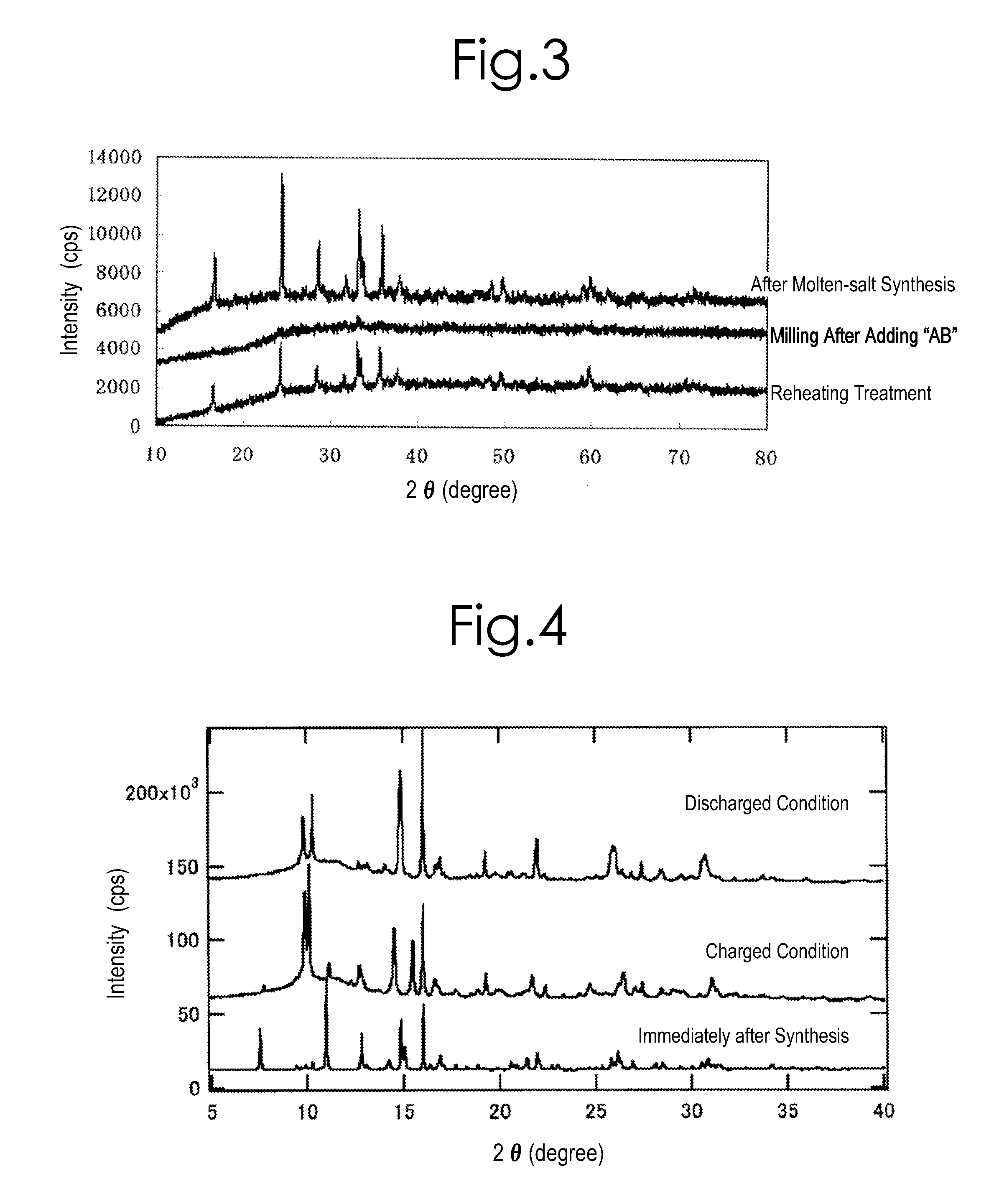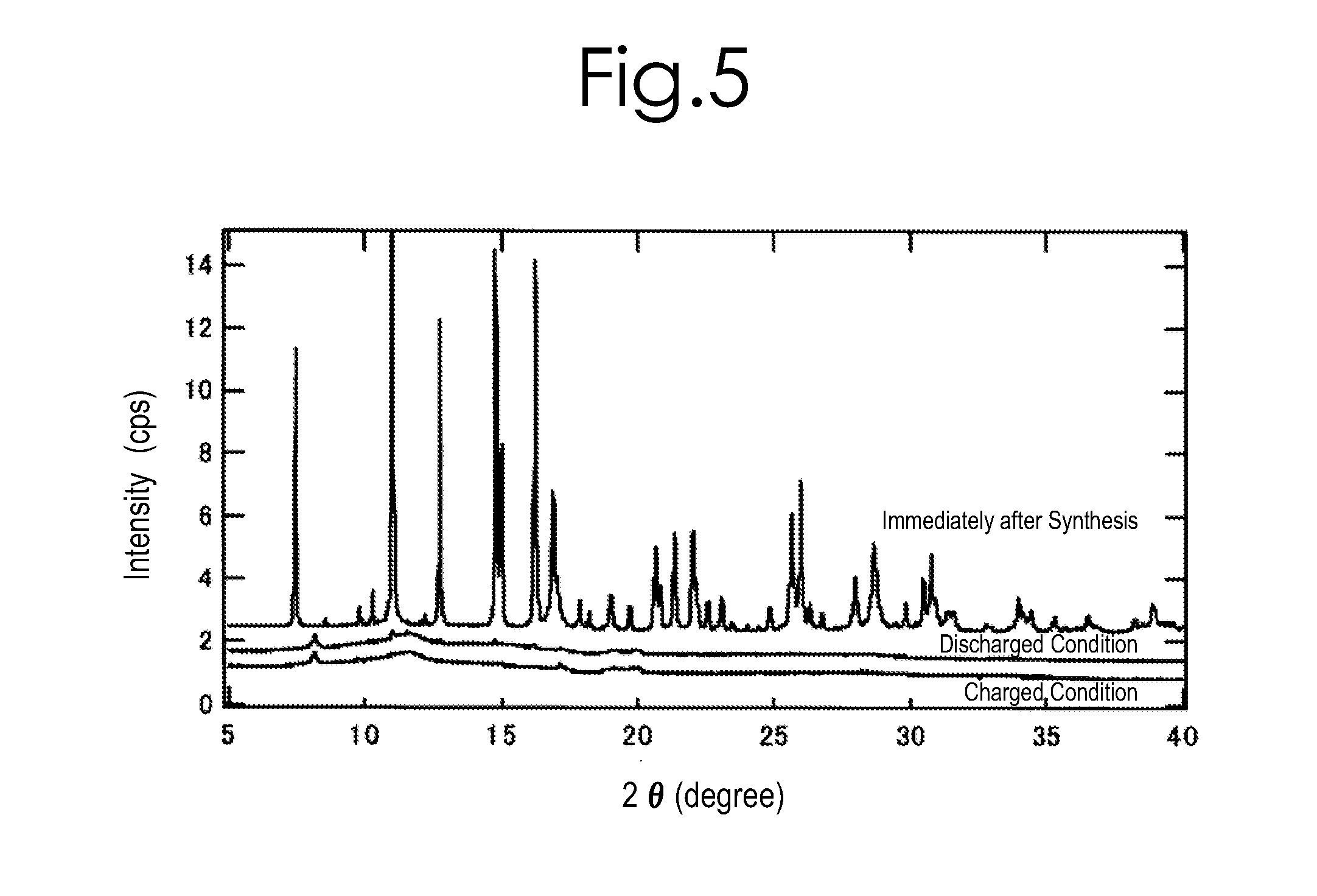Production process for lithium-silicate-system compound
a lithium-silicate system and lithium-silicate technology, applied in the direction of non-metal conductors, cell components, sustainable manufacturing/processing, etc., can solve the problems of low capacity, low environmental load, and inability to withstand charging voltage, etc., to achieve low environmental load, reduce the effect of oxygen elimination and high capacity
- Summary
- Abstract
- Description
- Claims
- Application Information
AI Technical Summary
Benefits of technology
Problems solved by technology
Method used
Image
Examples
example no.1
Example No. 1
Lithium-Rich Silicate-System Compound, and Charging-Discharging Characteristics of Battery Using the Same
[0183]
[0184]0.03 mol of iron oxalate, FeC2O4.2H2O (produced by SIGMA-ALDRICH, and with 99.99% purity), and 0.03 mol of lithium silicate, Li2SiO3 (produced by KISHIDA KAGAKU, and with 99.5% purity), were used as raw materials; and these were mixed with a carbonate mixture (e.g., one which was made by mixing lithium carbonate (produced by KISHIDA KAGAKU, and with 99.9% purity), sodium carbonate (produced by KISHIDA KAGAKU, and with 99.5% purity) and potassium carbonate (produced by KISHIDA KAGAKU, and with 99.5% purity) in a ratio of 0.435:0.315:0.25 by mol). The mixing proportion was set at such a proportion that a summed amount of the iron oxalate and lithium silicate was 225 parts by weight with respect to 100 parts by weight of the carbonate mixture. After adding 20 mL of acetone to these, they were mixed by a ball mill made of zirconia at a rate of 500 rpm for 60 ...
example no.2
Example No. 2
Manganese-Containing Lithium-Silicate-System Compound
[0201]A powder of manganese-containing lithium-silicate-system compound was obtained under the same conditions as those of Example No. 1, using manganese oxalate instead of the iron oxalate used in Example No. 1.
[0202]An X-ray diffraction measurement was carried out for the obtained product by means of a powder X-ray diffraction apparatus with use of the CuKα ray. The XRD pattern of this product agreed with the XRD pattern of orthorhombic crystal in the space group “Pmn21” virtually.
[0203]Moreover, it was possible to ascertain that the product was a powder that comprised crystal particles with about 200 nm or less by means of a scanning electron microscope (or SEM) observation. In addition, as a result of doing elemental analysis for the aforesaid product by means of an inductively-coupled plasma (or ICP) method, it was possible to ascertain that it came to have a compositional formula, Li1.980Na0.016K0.025Mn1.062SiO4...
example no.3
Example No. 3
[0212]Lithium-rich silicate-system compounds, which were expressed by a compositional formula: Li2+a+bAbM1-xM′xSiO4+c (in the formula, “A” is at least one element that is selected from the group consisting of Na, K, Rb and Cs; “M” is at least one element that is selected from the group consisting of Fe and Mn; “M′” is at least one element that is selected from the group consisting of Mg, Ca, Co, Al, Ni, Nb, Ti, Cr, Cu, Zn, Zr, V, Mo and W; and the respective subscripts are specified as follows: 0≦x≦0.5; 0<a<1; 0≦b<0.2; and 0<c<0.3), were synthesized in the same manner as Example No. 1, except that transition-metal components being in compliance with target compositions shown in Tables 9 and 10 below were used instead of the iron oxalate that was used in the process according to Example No. 1.
[0213]Note that, as for the raw materials, the following were used: iron oxalate, FeC2O4.2H2O (produced by SIGMA-ALDRICH, and with 99.99% purity); lithium silicate, Li2SiO3 (produce...
PUM
 Login to View More
Login to View More Abstract
Description
Claims
Application Information
 Login to View More
Login to View More - R&D
- Intellectual Property
- Life Sciences
- Materials
- Tech Scout
- Unparalleled Data Quality
- Higher Quality Content
- 60% Fewer Hallucinations
Browse by: Latest US Patents, China's latest patents, Technical Efficacy Thesaurus, Application Domain, Technology Topic, Popular Technical Reports.
© 2025 PatSnap. All rights reserved.Legal|Privacy policy|Modern Slavery Act Transparency Statement|Sitemap|About US| Contact US: help@patsnap.com



